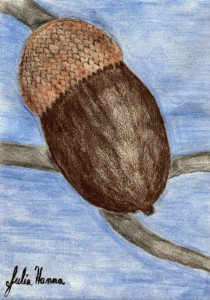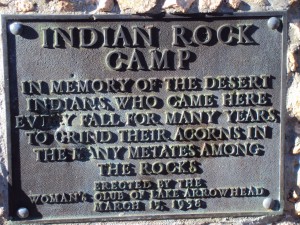The Serrano Indians And The Indian Rock Camp
June 6, 2013 in American History, general history, Pacific History
Today most people do not think much about acorns, except to put these in the category as being beautiful objects to collect nature walks. Crafters might use acorns to create a fall or winter decorations, but how many people actually think about eating acorns? About three hundred years ago there were no grocery stores in Southern California, and Native American tribes had to hunt and gather all of their food. Survival depending on rudimentary concerns such as food and shelter, but people still managed to enjoy life. Actually, the simple life probably had more perks to it over the hectic and chaotic schedules that us modern people live. Acorns were a staple food for the Serrano Indians of the San Bernardino Mountains, and they even used the caps of the acorns to fashion dice for games they played. However, how does someone go about eating an an acorn? First off, it has to be cracked open, and then soaked in water because it has a very bitter taste due to the tannic acid in the meat of the acorn . The Serrano Indians had camps near groups of large acorn trees since these were their main source of food. The Serranos are known by their Spanish name, which means mountain dwellers, but in their own language they referred to themselves as Yuhaviatam, which means people of the pines.
The Serranos were hunters and gathers who caught small game, but their main source of grains consisted of grinding acorns and pinon nuts. Acorns were cracked open with rocks, and soaked in water to leech out the bitter taste. After the bitter tannic acid was drained from the acorn meat, it was ground into a fine acorn meal used to make flat breads.
The place where the Serranos ground their acorns were on large rocks, which are called metates in Spanish. The Indian Rock Camp is located in the San Beranrdino Mountains, and a plaque was dedicated to the Serrano people by the Lake Arrowhead Woman’s Club in 1938.
Below is a video showcasing the photography of the Indian Rock camp where the Serranos used to grind acorns. Unfortunately, there is most certainly a dearth of printed or online information on the Serrano Indians, but perhaps someone will publish a book with more research and information in the near future to fill some of the gaps.


Aya Katz said on June 7, 2013
Thanks for this glimpse into the lives of the Serrano. It is also very interesting to learn about acorns as a staple food.
I think that today many of us overlook inexpensive ways to produce our own food because we have been conditioned to think that food comes from a supermarket. But in tougher economic climates, people may need to tall back on historical food sources and methods of processing food.
I wonder how much fat and protein there is in an acorn-based flat bread. One of the problems with modern bread is that all the fats and proteins from the grains have been removed, leaving only carbs.
J-Hanna said on June 8, 2013
Here is the nutritional content of acorns: http://nutritiondata.self.com/facts/nut-and-seed-products/3083/2
Governor said on June 8, 2013
It looks very nutritious!